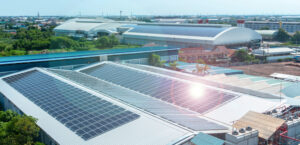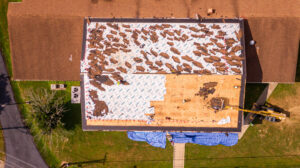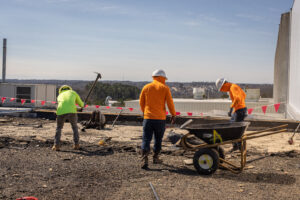Flat roofs offer a sleek aesthetic and practical benefits for modern buildings, but their unique drainage needs can leave many feeling overwhelmed. This comprehensive guide is your one-stop shop for mastering flat roof drainage, ensuring your roof’s longevity and trouble-free performance.
Here’s what you’ll discover:
- Secrets of effective flat roof drainage and tackle common issues head-on.
- Different drainage systems, from inner drains to innovative siphonic solutions.
- Discover how climate, location, and roof materials impact your drainage needs.
- Learn best practices for maintenance and troubleshoot common problems with ease.
- Valuable insights from real-life case studies and expert advice.
By the end of this guide, you’ll be equipped with the knowledge and confidence to optimize your flat roof drainage system and ensure its long-lasting performance.
Table of Contents
What is Flat Roof Drainage
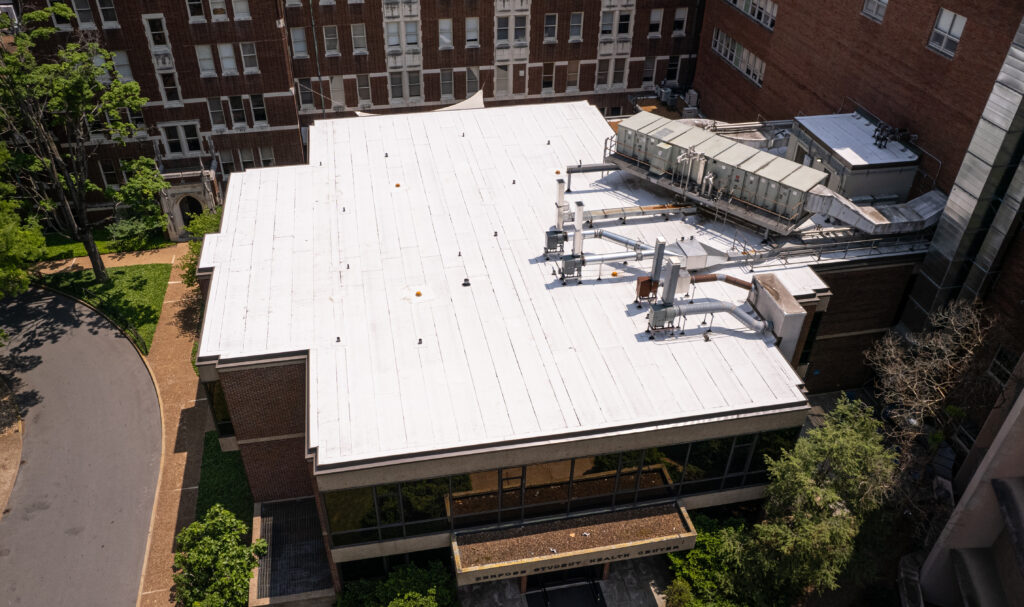
Contrary to popular belief, flat roofs are not completely level. They are designed with a slight slope to facilitate water drainage. Understanding this fundamental aspect is key to comprehending how flat roofs drain and why proper drainage systems are vital.
The primary objective of any flat roof drainage system is to remove water as efficiently as possible. This involves strategically placed drains and a well-thought-out design to prevent water accumulation, which can lead to leaks and structural damage.
Key Types of Flat Roof Drainage Systems
Inner Drains
Inner drains are installed away from the edges of the roof, typically at the lowest point where water is likely to collect. They are connected to pipes beneath the roof that channel water away from the building. This system is advantageous in colder climates as the internal placement of the pipes reduces the risk of freezing.
Scuppers
Scuppers are openings in the parapet walls that allow water to drain off the sides of the building. They are effective in quickly removing water, especially in areas with heavy rainfall. However, they require regular maintenance to prevent blockages and ensure efficient water flow.
Gutters
Gutters are installed along the roof edges and direct water into downspouts. While they are a cost-effective solution for smaller buildings, gutters need frequent cleaning to prevent clogs from debris like leaves and twigs.
Siphonic Roof Drains
A siphonic roof drain system uses a vacuum mechanism to draw water from the roof at high speeds. It is an ideal choice for large commercial buildings with extensive roof areas.
Tapered Insulation
Tapered insulation helps create a slope on flat roofs, enhancing drainage. It is an effective solution for addressing areas prone to water pooling and also improves the building’s thermal efficiency.
Climate and Location Considerations
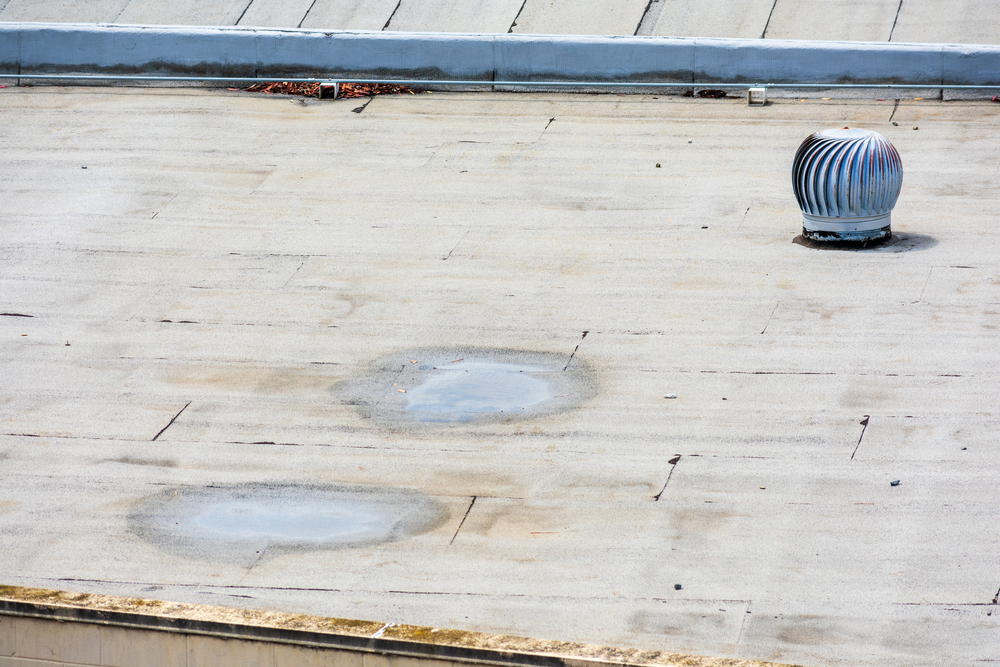
Impact of Different Climates
Every region boasts its own unique climatic personality, and understanding these nuances is crucial when designing a robust and efficient drainage system for your flat roof. Let’s explore how various climates influence your drainage needs:
1. Snow-Prone Regions
- The Challenge: Heavy snowfall can accumulate on flat roofs, placing immense weight and pressure. Additionally, melting snow can overwhelm drainage systems, leading to ponding water and potential leaks.
- Solution:
- Slope: Ensure sufficient roof slope (ideally 2-5%) to encourage snowmelt runoff and minimize accumulation.
- Heated Drains: Implement heated drain systems that melt snow and ice effectively, preventing ponding and drainage issues.
- Siphonic Systems: Consider siphonic drainage systems, which utilize the Venturi effect to rapidly remove large volumes of water, including melted snow.
- Gutters and Downspouts: Install adequately sized gutters and downspouts to efficiently channel snowmelt away from the roof’s perimeter.
2. Rain-Heavy Areas
- The Challenge: Constant or intense rainfall can overwhelm drainage systems, leading to ponding water and potential leaks. Additionally, strong winds can complicate drainage, causing water to pool in unexpected areas.
- Solution:
- Increased Capacity: Opt for drainage systems with higher capacity to handle large volumes of rainwater efficiently.
- Multiple Drains: Strategically position multiple drains across the roof to ensure even distribution of water flow and prevent ponding.
- Overflow Systems: Implement overflow systems as a safety measure to prevent water from backing up and causing damage.
- Wind Deflectors: Consider installing wind deflectors around drains and gutters to minimize the impact of strong winds on rainwater flow.
3. Hot and Arid Climates
- The Challenge: Intense heat and sun exposure can lead to rapid water evaporation, potentially causing membrane damage and reduced drainage efficiency.
- Solution:
- Reflective Coatings: Apply reflective coatings to the roof surface to reduce heat absorption and minimize water evaporation.
- Insulated Drainage Systems: Choose insulated drainage systems that protect the membrane from extreme heat and prevent damage.
- Water-Retention Membranes: Consider water-retention membranes that capture and store rainwater for later use, promoting sustainability and reducing reliance on external water sources.
4. Coastal Regions
- The Challenge: Coastal areas are exposed to salt water spray, which can corrode drainage system components and accelerate material degradation.
- Solution:
- Corrosion-Resistant Materials: Use drainage systems made from corrosion-resistant materials like stainless steel or PVC to withstand the harsh coastal environment.
- Regular Maintenance: Implement a rigorous maintenance program to ensure proper cleaning and inspection of drainage components to prevent corrosion and damage.
Recommendations Based on Regional Considerations
| Climate Type | Recommended Drainage System |
|---|---|
| Heavy Snowfall | Inner Drains, Tapered Insulation |
| Frequent Rain | Scuppers, Siphonic Roof Drains |
| Extreme Heat | Gutters, Tapered Insulation |
Tailoring Your System to Your Specific Location

Charlotte, NC: This warm, humid subtropical city with hot summers, mild winters, and moderate rainfall requires an increased capacity drainage system, reflective coatings to combat the sun’s heat, and wind deflectors to manage strong winds.
Raleigh, NC: Similar to Charlotte, Raleigh necessitates an emphasis on increased drainage capacity due to its moderate to heavy rainfall. Additionally, an overflow system might be a wise investment as a safety precaution, and siphonic systems could be considered for efficient handling of intense rain events.
Dalton, GA: Sharing a similar climate to Charlotte and Raleigh, Dalton requires a focus on adequate drainage capacity. However, heated drains might be necessary in specific areas prone to occasional snowfall. Regular maintenance ensures the system functions optimally year-round.
Rock Hill, SC: Like Raleigh, Rock Hill emphasizes increased drainage capacity due to moderate to heavy rainfall. Wind deflectors are recommended to manage strong winds, and regular maintenance and inspection are crucial to prevent potential issues arising from heavy rain.
Cities in Tennessee:
- East Tennessee: Similar to cities in North Carolina and South Carolina, drainage considerations focus on increased capacity, wind deflectors, and regular maintenance.
- Middle Tennessee: With slightly less rainfall than East Tennessee, the drainage system capacity can be adjusted accordingly.
- West Tennessee: Hot and humid, these regions require reflective coatings and heat-resistant materials to protect the system from the intense sun and heat.
Roof Materials and Drainage Compatibility
The type of roofing material significantly influences the choice of drainage system. Materials like EPDM, TPO, and BUR have unique properties that affect water flow and accumulation, necessitating specific drainage solutions.
Compatibility Issues
Mismatching the drainage system with the roofing material can lead to a number of problems, including:
Ponding water: This can lead to leaks, membrane damage, and even structural issues.
Inefficient drainage: Poorly designed systems can leave water stagnating on the roof, increasing the risk of damage.
Corrosion: Incompatible materials can react with each other, leading to corrosion and premature system failure.
| Roofing Material | Ideal Drainage System |
|---|---|
| EPDM | Inner Drains, Scuppers |
| TPO | Gutters, Siphonic Drains |
| BUR | Tapered Insulation, Scuppers |
Ensuring Optimal Performance
By carefully matching the drainage system to the roofing material, you can ensure:
- Long-term durability: Both the roof and the drainage system will last longer when they work together seamlessly.
- Optimal drainage performance: Water will be efficiently removed from the roof, preventing ponding and other problems.
- Reduced maintenance costs: A well-designed system will require less maintenance and repair over the long term.
Comparison of Materials
| Material | Pros | Cons |
|---|---|---|
| Cast Iron | Durable, Quiet | Expensive |
| PVC | Cost-effective, Easy to shape | Less durable |
| Propylene | Fire-resistant, Solvent-resistant | Lightweight, Poor for drain covers |
| ABS | Similar to PVC | Performs poorly in sunlight |
Design Considerations for Effective Drainage
From ensuring proper slope to strategically placing drains, every detail plays a crucial role in maximizing water removal efficiency and preventing potential problems.
The Importance of Slope
Imagine a flat roof with no slope. Rainwater would simply pool on the surface, potentially leading to ponding, leaks, and membrane damage. This is why a well-designed slope is crucial for effective drainage. Even a minimal incline, typically ranging from 1:40 to 1:80, can significantly enhance water flow towards drainage points, preventing stagnation and safeguarding your roof’s integrity.
Strategic Placement of Drains
Just like strategically positioning soldiers on a battlefield, drains should be carefully placed at the lowest points of the roof to maximize water removal efficiency. This ensures that water flows effortlessly towards the drains, preventing ponding and minimizing the risk of leaks and structural damage. The number and location of drains will depend on the size and shape of the roof, as well as the expected rainfall intensity.
Crickets: Small Heroes of Drainage
Picture a small, raised structure on your flat roof, resembling a miniature mountain range. These are crickets, and they play a critical role in water diversion. Especially around obstacles like HVAC units, crickets help divert water flow towards drains, ensuring that even the most challenging areas are effectively drained. By preventing water ponding around these obstacles, crickets minimize the risk of leaks and corrosion, protecting your roof for years to come.
Membrane Protection and Maintenance
Your flat roof’s waterproofing membrane acts as its shield, safeguarding the building from the elements. However, during installation and maintenance of drainage systems, this vital layer can be vulnerable to damage. To ensure the long-term health and performance of your roof, meticulously protecting and maintaining the membrane is crucial.
Safeguarding During Drainage Installation
- Careful Material Handling: Handle all materials with care to avoid punctures, tears, or abrasions to the membrane.
- Minimal Contact: Minimize foot traffic and equipment movement on the membrane to prevent accidental damage.
- Protective Coverings: Use plywood or other protective materials to shield the membrane from impact, scratching, and debris during installation processes.
Regular Cleaning and Inspection
- Debris Removal: Regularly remove leaves, branches, and other debris from the roof to prevent ponding and potential membrane damage.
- Thorough Cleaning: Use a soft brush and appropriate cleaning solutions to remove dirt, grime, and algae buildup from the membrane.
- Inspection for Issues: Inspect the membrane regularly for punctures, tears, or blisters. Promptly address and repair any damage to prevent leaks and further deterioration.
Addressing Membrane Issues
- Small Tears and Punctures: These can often be repaired using specialized sealant or patching kits.
- Extensive Damage: For larger tears or widespread deterioration, it may be necessary to replace the affected area of the membrane or even the entire roof.
Other Maintenance Tips
- Maintain Drainage System: Regularly clean and inspect drains, gutters, and downspouts to ensure proper water flow and prevent backups.
- Vegetation Control: Remove any unwanted vegetation growing on the roof to prevent root penetration and damage to the membrane.
- Professional Maintenance: Consider scheduling annual inspections and maintenance with a qualified roofing contractor to detect and address potential issues before they become major problems.
Troubleshooting Common Flat Roof Drainage Issues
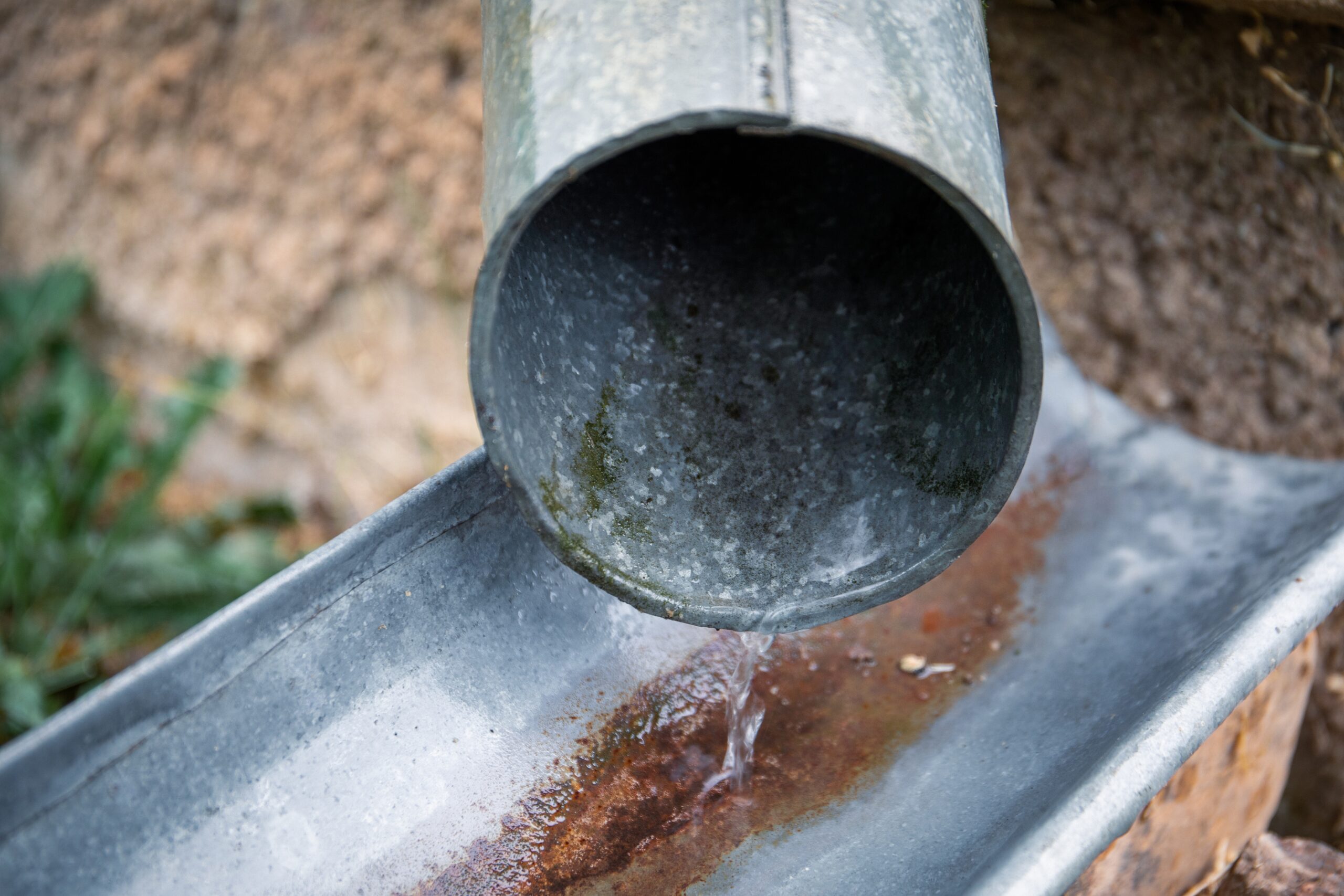
Even the most meticulously designed and installed flat roof drainage system can encounter challenges over time. Recognizing and proactively addressing these issues can prevent more costly problems from developing and ensure the long-term health and performance of your roof.
Ponding Water: A Recurring Challenge
After heavy rainfall, water accumulates in certain areas, forming stagnant pools known as ponding. This can lead to a cascade of problems, including:
- Membrane damage: Constant exposure to water can deteriorate the membrane, leading to leaks and structural issues.
- Roof rot: Moisture trapped beneath the membrane can cause the underlying roof deck to rot and decay.
- Increased weight: Excessive water adds significant weight to the roof, potentially overloading its structural capacity.
Combating Ponding
- Regular Inspection: Regularly check for ponding after heavy rainfall and address any areas where water accumulates.
- Slope Adjustment: If the existing slope is insufficient, consider adding additional slope to promote water flow towards drains.
- Drainage System Enhancement: Evaluate the effectiveness of your drains and gutters. If necessary, upgrade or add additional drainage points to improve water removal efficiency.
Clogged Drains and Gutters: Enemies of Smooth Flow
Over time, leaves, twigs, and other debris can accumulate in drains, gutters, and downspouts, hindering water flow and causing blockages. These blockages can lead to:
- Overflowing drains: Water will have nowhere to go but over the edge of the roof, potentially causing damage to walls and landscaping.
- Membrane stress: Backed-up water can put immense pressure on the membrane, increasing the risk of leaks and tears.
- Ice dams: In cold climates, frozen water can form around drain openings, leading to ice dams and further drainage problems.
Preventing Clogs and Blockages
- Regular Cleaning: Regularly clean drains, gutters, and downspouts to remove debris and ensure unobstructed water flow.
- Protective Guards: Install mesh screens or other guards over drains and gutters to prevent debris from entering the system.
- Winter Preparations: In cold climates, take proactive measures like heating cables or deicing solutions to prevent ice dams from forming around drains.
We hope that this guide has equipped you with the knowledge to master flat roof drainage, regardless of climate, materials, or challenges. Implement these insights to ensure your roof’s longevity and functionality, and enjoy the peace of mind that comes with knowing your investment is protected.

